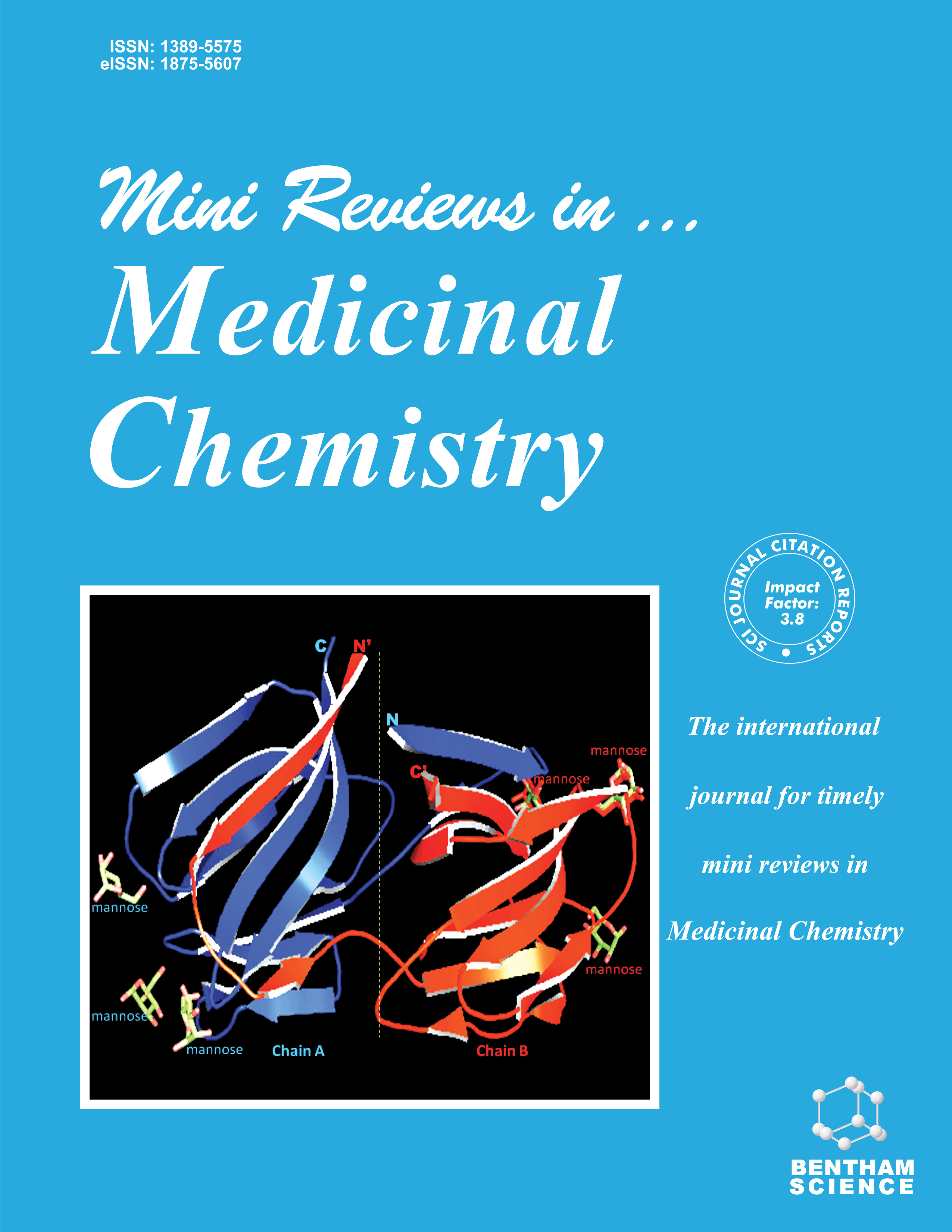Mini Reviews in Medicinal Chemistry - Volume 25, Issue 11, 2025
Volume 25, Issue 11, 2025
-
-
Recent Progress of Small-molecule Inhibitors of O-GlcNAcase for Alzheimer’s Disease
More LessO-GlcNAcylation is a non-canonical form of protein glycosylation that occurs in nuclear, cytoplasmic, and mitochondrial proteins among all multicellular eukaryotes. There are only two enzymes that regulate this post-translational modification, one of which is O-GlcNAcase, a glycoside hydrolase that catalyzes the hydrolytic cleavage of O-GlcNAc from protein substrates. Related studies have shown that the reduction of O-GlcNAc levels is closely related to Alzheimer's disease, which is maintained by reducing the aggregation of tau via inhibiting O-GlcNAcase. Various small-molecule O-GlcNAcase inhibitors with different chemical structures have been developed and used as chemical probes to explore the O-GlcNAc pathway. Although many reported inhibitors have shown that O-GlcNAcase activity has single-digit nmol IC50 values in binding assays, and molecules, such as LY-3372689, have entered phase II clinical studies, further exploration of novel O-GlcNAcase inhibitors with higher inhibitory activity and specificity is still worthy of attention. This article reviews the pathogenesis and therapeutic role of O-GlcNAcase in Alzheimer's disease, as well as the recent progress of O-GlcNAcase small molecule inhibitors, including sugar-derived or non-sugar scaffolds, and summarizes the clinical progress and potential prospects of O-GlcNAcase inhibitors.
-
-
-
Innovations in Cannabis Delivery Systems: A Patent Review (2012-2024)
More LessIntroductionCannabis sativa has been cultivated for over 11,700 years, originating in Central and Southeast Asia, and has been used for medical, recreational, and religious purposes. Among its therapeutic potentials, it is notable for its capacity to alleviate pain, nausea, anxiety, and more. The plant’s primary secondary metabolites are cannabinoids, which interact with the endocannabinoid system to produce these effects. However, due to the dosage variability and the secondary effects associated with a lack of targeted action, their medical use is limited, creating the need for effective delivery systems.
MethodologyThis systematic patent review on cannabis drug delivery systems was conducted using patents retrieved from the Espacenet database. The search employed the keywords “Cannabis” and “Delivery,” along with the IPC classification code A61, to filter patents filed between 2012 and 2024. This initial search yielded 99 patents, which were further screened to identify 15 patents that met the inclusion criteria.
ResultsOf the selected patents, most originated from the United States, followed by Canada, international patents (WIPO), and China. A notable increase in patent filings occurred in 2022, coinciding with the peak in scientific publications on the topic. This trend indicates a growing interest in the design of cannabis delivery systems.
DiscussionThe historical importance and therapeutic potential of Cannabis sativa are well-documented, yet modern medical use remains restricted due to pharmacokinetic limitations. Delivery systems such as extracellular vesicles, microneedles, and emulsions have been developed to improve the bioavailability and stability of cannabinoids. Extracellular vesicles facilitate targeted, non-invasive delivery of cannabinoids to the central nervous system. Microneedles offer a painless method for transdermal administration, overcoming skin barrier limitations. Emulsions improve the solubility and bioavailability of lipophilic cannabinoids, making them suitable for various administration routes.
ConclusionSince 2012, there has been considerable growth in patents and publications related to cannabis drug delivery systems, driven by the therapeutic potential of cannabinoids. Innovations in delivery systems like emulsions, microneedles, and extracellular vesicles aim to improve the pharmacokinetics and therapeutic efficacy of cannabis-derived compounds, representing a shift towards medical cannabis applications.
-
-
-
Bioactive Sulfonamides Derived from Amino Acids: Their Synthesis and Pharmacological Activities
More LessAuthors: Melford Chuka Egbujor, Paolo Tucci and Luciano SasoCurrently, the synthesis of bioactive sulfonamides using amino acid as a starting reagent has become an area of research interest in organic chemistry. Over the years, an amine-sulfonyl chloride reaction has been adopted as a common step in traditional sulfonamide synthetic methods. However, recent developments have shown amino acids to be better precursors than amines in the synthesis of sulfonamides. Although amines and amino acids have some structural similarities, using amino acids rather than amines in the synthesis of sulfonamides minimizes several drawbacks. Comparatively, amino acids are preferred to amines as starting reagents in sulfonamide synthesis due to their biological relevance, chirality, stereochemistry, diversity of side chains, orthogonality in functional group manipulation, the potential for peptide and protein synthesis, mild reaction conditions, alignment with green chemistry principles, diverse synthetic applications, easy availability, and economic viability. Amino acids, having the aforementioned properties, offer a versatile platform for the synthesis of sulfonamides with tailored structures. The reaction mechanism of the synthesis of amino acid-derived sulfonamides involves a nucleophilic attack by the amino group on the activated sulfonyl species to produce a sulfonamide functional group. Amino acid-based sulfonamides have numerous pharmacological activities, including antibacterial, antiviral, anticancer, antioxidant, anti-inflammatory, anti-plasmodial, antimalarial, anti-trypanosomal, and insect growth regulatory properties. This review discusses several synthetic processes, emphasizing established ways, cutting-edge techniques, and novel approaches that emphasize the significance of amino acids in the synthesis of sulfonamides. The structure-activity relationship of amino acid-derived sulfonamides and their pharmacological activities are also highlighted.
-
Volumes & issues
-
Volume 25 (2025)
-
Volume 24 (2024)
-
Volume 23 (2023)
-
Volume 22 (2022)
-
Volume 21 (2021)
-
Volume 20 (2020)
-
Volume 19 (2019)
-
Volume 18 (2018)
-
Volume 17 (2017)
-
Volume 16 (2016)
-
Volume 15 (2015)
-
Volume 14 (2014)
-
Volume 13 (2013)
-
Volume 12 (2012)
-
Volume 11 (2011)
-
Volume 10 (2010)
-
Volume 9 (2009)
-
Volume 8 (2008)
-
Volume 7 (2007)
-
Volume 6 (2006)
-
Volume 5 (2005)
-
Volume 4 (2004)
-
Volume 3 (2003)
-
Volume 2 (2002)
-
Volume 1 (2001)
Most Read This Month


